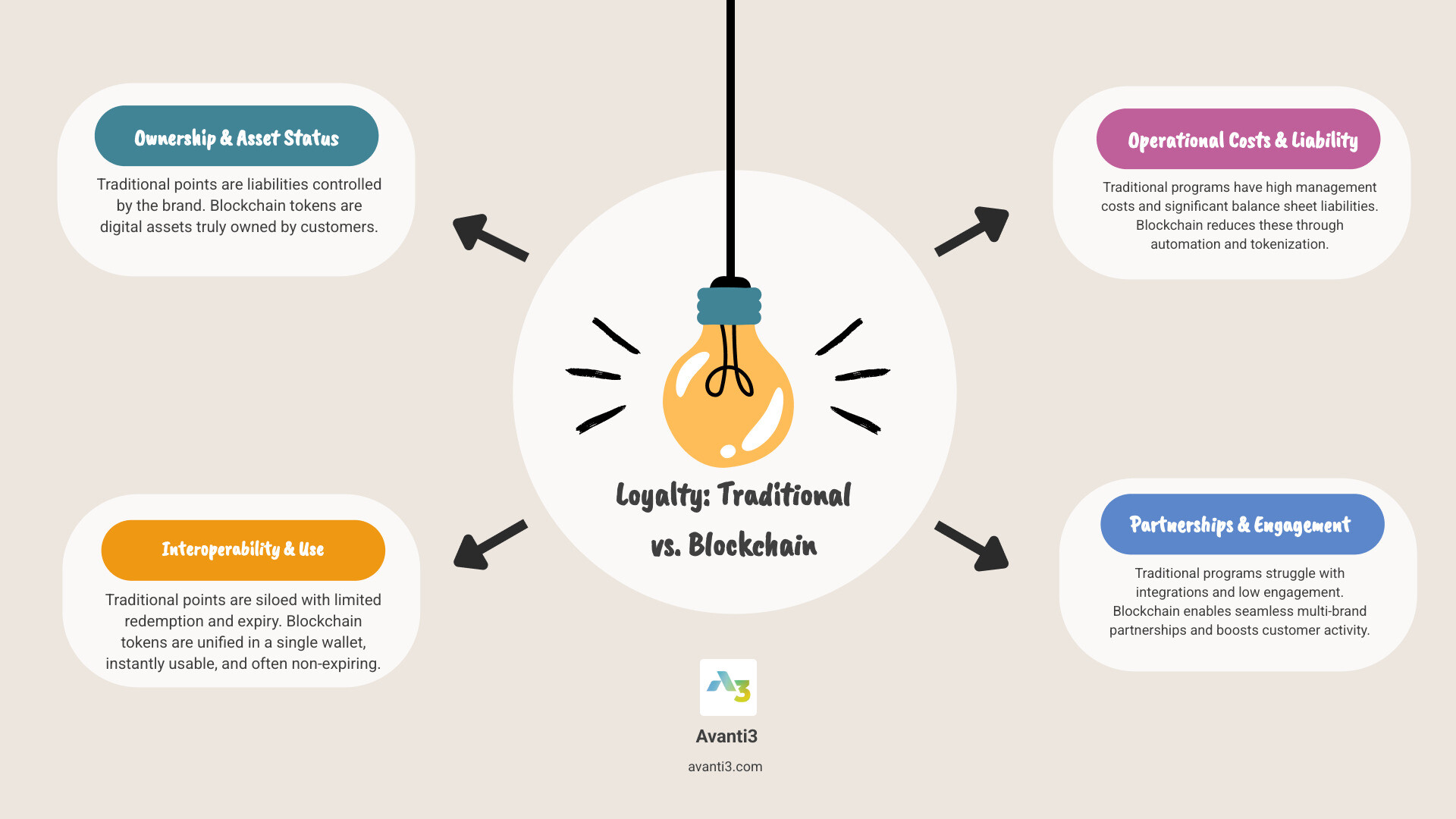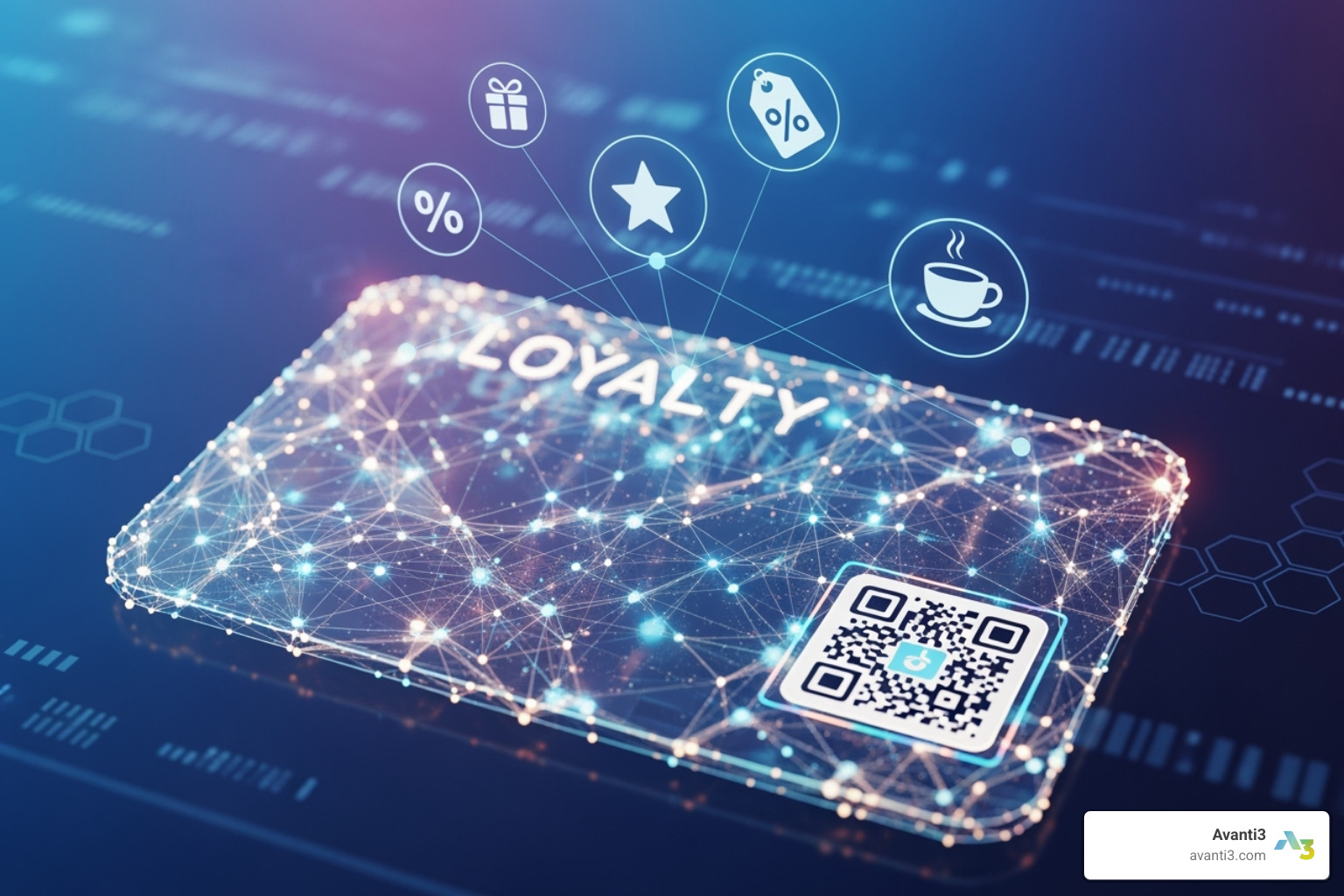Loyalty programs using blockchain: 2025 Revolution
Understanding Loyalty Programs Using Blockchain
For years, loyalty programs have been a staple for customer retention. Now, loyalty programs using blockchain are changing the game by solving the persistent problems that made traditional rewards programs frustrating for both customers and businesses.
Here’s how blockchain reshapes loyalty:
-
For Customers:
- True Ownership: Points become digital assets you truly own.
- Single Wallet: Manage all rewards in one digital wallet.
- Instant Use: Redeem points instantly without complex processes.
- More Options: Exchange or trade points across different brands.
- No Expiry: Hard-earned rewards won’t disappear.
-
For Businesses:
- Lower Costs: Reduce system management and transaction fees.
- Less Liability: Alleviate balance sheet burdens from unredeemed points. (One major airline holds over $700 million in such deferred revenue.)
- New Partnerships: Easily connect with other brands for flexible networks.
- Boosted Engagement: Customers are more likely to use points they truly own.
- Fraud Protection: Secure, unchangeable records reduce fraud.
This powerful technology is ready to revolutionize customer engagement by blending innovation with strategy, moving loyalty from a liability to a valuable asset for businesses and consumers alike.

The Problem with Points: Why Traditional Loyalty Programs Are Failing
Traditional loyalty programs, while well-intentioned, often fall short, creating frustration for customers and a significant burden for businesses.

Inefficiencies for Customers
The average household belongs to nearly 30 different loyalty programs, making them difficult to manage. This leads to several frustrations:
- Siloed Systems: Points earned with one brand are usually stuck there. This fragmentation means customers need separate accounts and must learn different rules for each program.
- Confusing Rules and Redemption Headaches: Many programs have complex rules, blackout dates, and limitations. Earning enough points for a meaningful reward can take six to nine months, by which time the rules may have changed.
- Point Expiration: Customers often save up points only to find they’ve vanished due to an arbitrary expiration date, which feels more like a punishment than a reward.
- Limited Options: The available rewards are often a narrow selection that doesn’t align with what customers truly want or need, leading to unused points.
- Poor User Experience: Tracking multiple programs and redeeming rewards is often a chore. It’s no surprise that while most consumers are in at least one program, they only actively use a handful.
Burdens for Businesses
Businesses also face significant challenges with traditional loyalty models:
- High Operational Costs: There are major expenses for system management, transaction processing, and fraud prevention, which drain resources.
- Fraud and Errors: Centralized programs are vulnerable to fraud and human error, which can cost money and erode customer trust.
- Unredeemed Points as a Liability: Every unredeemed point sits on a company’s books as a deferred revenue liability. For example, one major airline once held a staggering $700 million in deferred revenue from its loyalty program. This ties up capital and complicates finances.
- Difficulty in Forming Partnerships: Creating and managing shared loyalty programs is complex and slow, limiting the creation of broader reward networks that customers desire.
- Measuring ROI and Low Customer Activity: It’s tough for businesses to measure a program’s effectiveness. If customers aren’t engaged, the program isn’t driving repeat business, and the investment is wasted.
Traditional loyalty programs have become a maze of complexity. But what if these burdens could become benefits? That’s where loyalty programs using blockchain step in.
More info about Digital Brand Engagement
How Loyalty Programs Using Blockchain Offer a Superior Alternative
Imagine loyalty points as flexible as cash—points you own, can trade, and that never expire. This is what loyalty programs using blockchain deliver.
At its core, blockchain is a transparent and permanent distributed ledger. Combined with smart contracts (self-executing agreements) and tokenization (turning points into digital assets), it creates a system. The key is interoperability, allowing loyalty tokens to move seamlessly between different brands and platforms. Instead of being trapped, your rewards become part of a connected, flexible ecosystem.

Key Benefits for Businesses
For companies, blockchain-based loyalty programs solve real financial headaches and create competitive advantages.
- Reduced Costs & Automated Management: Smart contracts automate point issuance, redemption, and rule enforcement, eliminating manual processing and lowering transaction fees.
- Lower Liability: Because points are easier to use and trade, customers redeem them more often. This reduces the massive balance sheet liabilities associated with unredeemed points, like the $700 million held by one major airline.
- Seamless Partner Integration: Brands can connect their loyalty systems almost instantly, creating richer redemption options for customers and expanding each brand’s reach.
- Improved Security and Fraud Prevention: Blockchain’s immutable ledger makes tampering nearly impossible, creating an unbreakable chain of evidence that deters fraud.
- Transparent Auditing: With every transaction on a public ledger, businesses and customers can verify rewards, track points, and resolve disputes quickly, building trust.
The Blockchain Revolution For Loyalty Programs
Opening Up New Value for Customers
Loyalty programs using blockchain put consumers in control of their rewards.
- True Asset Ownership: Loyalty tokens belong to you, stored in your digital wallet and recorded on the blockchain. Companies can’t unilaterally change the rules or take away your points.
- Universal Digital Wallet: Consolidate all your rewards in one place instead of juggling dozens of apps and cards.
- Instant Redemption: Blockchain processes redemptions immediately, eliminating frustrating wait times.
- Trading and Exchanging Points: Trade airline miles for hotel points or even exchange some tokens for other cryptocurrencies or cash, adding real financial value.
- No Arbitrary Expiration: Since you own the tokens on an immutable ledger, they don’t vanish after a set time.
- Increased Trust and Transparency: You can verify every transaction, building genuine trust with the brands you support.
Traditional vs. Blockchain Loyalty Programs
The difference is a fundamental reimagining of loyalty. Ownership shifts from brand-controlled liabilities to customer-owned assets. Transferability evolves from siloed points to interoperable tokens. Security improves from vulnerable centralized systems to tamper-proof decentralized ledgers. Transparency moves from opaque rules to full visibility, and Cost drops from high operational expenses to automated efficiency.
A Practical Guide to Implementing a Blockchain Loyalty Program
Transitioning to loyalty programs using blockchain is a strategic journey involving careful planning, smart technology choices, and a focus on user experience.

Step 1: Define Your Goals and Tokenomics
Before any technical work, define your strategy. Assess your current program’s pain points and set clear objectives, such as reducing liability from unredeemed points, boosting engagement, or attracting new partners.
Next, design your reward token. You can use fungible tokens, which are interchangeable like standard points but on the blockchain, or NFTs (Non-Fungible Tokens) for unique rewards like exclusive memberships or digital collectibles. Finally, establish your “tokenomics”: define the token’s value, how it’s earned, and the rules for exchange with other brands to ensure a stable and appealing program.
More info about NFT Engagement Tools
Step 2: Choose Your Blockchain Architecture
This technical decision impacts your program’s speed, security, and cost. You’ll choose between:
- Public Blockchains (e.g., Ethereum, Polygon): These offer high transparency and decentralization but can have variable transaction costs and slower speeds.
- Private Blockchains (e.g., Hyperledger Fabric): These provide greater control, speed, privacy, and lower costs, often making them a better fit for enterprise loyalty programs.
You must also consider scalability solutions to handle growth without slowdowns, and prioritize transaction speeds and security to protect customer rewards and company data. Finally, you’ll choose a development platform, deciding whether to use an existing framework or build a custom solution.
More info about Web3 Platform Solutions
Step 3: Develop the Platform and User Interface
This step brings the program to life for your customers.
- Smart Contract Development: Developers write and deploy self-executing contracts that automate everything from issuing and trading tokens to processing redemptions.
- Digital Wallet Creation: Provide customers with a simple, intuitive digital wallet to store and manage their tokens. The key is to “abstract away” the blockchain complexity so the experience is seamless.
- Partner Integration APIs: Develop APIs (digital bridges) to allow your system to connect easily with other brands for cross-program reward exchanges.
- Simple User Experience: The ultimate goal is an interface so easy to use that customers don’t need to understand blockchain to enjoy its benefits.
Key considerations and potential risks for loyalty programs using blockchain
While the benefits are significant, it’s smart to be aware of potential challenges:
- Transaction Costs (Gas Fees): On public blockchains, transaction fees can be volatile, which may impact program design.
- Data Privacy and Control: Program design must protect customer privacy, especially in coalition models, and comply with regulations like GDPR.
- Token Value Volatility: If tokens are tradable, their value may fluctuate. This risk can be managed with clear communication or by using stablecoins.
- Regulatory Uncertainty: The legal landscape for digital assets is evolving, so staying compliant is crucial.
- User Adoption and Education: Some customers may be hesitant about new technology. Clear communication and a user-friendly design are key to encouraging adoption.
Real-World Applications and the Future of Engagement
Loyalty programs using blockchain are no longer just a concept; they are being actively used by businesses across various industries, proving the technology’s transformative power.
Examples Across Industries
- Airlines: The travel industry is a natural fit. One major airline’s KrisPay program lets customers use frequent flyer miles with partner merchants, making rewards more flexible than ever.
- Retail Sector: Blockchain enables multi-brand retail coalitions where loyalty tokens can be spent across a network of stores. Major coffee chains are also using it to offer more customized rewards.
- E-commerce: Some online retailers have converted loyalty points into cryptocurrency, giving customers the freedom to spend points on the platform or transfer them to personal crypto wallets.
- Financial Services: Banks are using blockchain to enable instant reward collection and use. American Express has used the technology to help businesses create direct, customized offers for cardholders.
- Gaming and Entertainment: Game companies are issuing rewards like NFTs and unique digital items that players truly own and can trade on marketplaces. Sports groups use NFTs to engage fans with verifiable rewards for activities like trivia contests.
Making blockchain real for customer loyalty programs | Deloitte US
The future of loyalty programs using blockchain
The future of customer loyalty is dynamic, personalized, and deeply connected with other technologies.
- Integration with AI and IoT: Future programs will likely integrate with AI to offer hyper-personalized rewards based on secure blockchain data. IoT devices could automatically issue rewards for actions like entering a store.
- Hyper-Personalization: With a perfect record of interactions on the blockchain, rewards can be based not just on purchases but on engagement, feedback, and content consumption.
- DeFi Features (Staking, Lending): Loyalty tokens may incorporate Decentralized Finance (DeFi) features, allowing customers to “stake” tokens to earn interest or use them as collateral for small loans.
- Gamification: Blockchain is a perfect foundation for gamified loyalty. Brands can create missions, badges, and achievement levels recorded on-chain, turning loyalty into an engaging experience, which is ideal for building active Community Loyalty Programs.
Frequently Asked Questions about Blockchain Loyalty Programs
It’s normal to have questions about new technology. Let’s tackle some common ones.
Are blockchain loyalty points the same as cryptocurrency?
They are related but distinct. Loyalty programs using blockchain use the same underlying technology, meaning your points are secure digital tokens. However, unlike general-purpose cryptocurrencies like Bitcoin, loyalty points are typically utility tokens designed for a specific brand ecosystem. Their value comes from what they can be redeemed for, such as discounts or exclusive access. Some advanced programs, however, do allow tokens to be exchanged for other cryptocurrencies or cash, blurring the lines and adding flexibility.
Is it expensive to build a blockchain loyalty program?
The initial investment varies based on complexity and whether you build from scratch or use a ready-made platform. However, it’s crucial to consider the long-term cost savings. Blockchain can dramatically cut ongoing operational costs through automation via smart contracts, reduced transaction fees, and lower fraud risk. The reduction in balance sheet liability from unredeemed points also provides significant financial benefits. Furthermore, the availability of SaaS (Software as a Service) and white-label solutions makes it more accessible and cost-effective for businesses of all sizes to get started.
Do my customers need to be crypto experts to use it?
Absolutely not. A primary goal when building loyalty programs using blockchain is to make them exceptionally user-friendly. The underlying blockchain complexity is abstracted away, meaning customers interact with a simple mobile app or digital wallet that feels familiar. They won’t need to understand concepts like “gas fees” or “private keys.” The powerful technology works behind the scenes, while customers simply enjoy a better, more rewarding loyalty experience.
Conclusion
The days of frustrating loyalty cards and expired points are numbered. What was once a hassle for customers and a liability for businesses is becoming a valuable digital asset, thanks to loyalty programs using blockchain.
This shift empowers customers with true ownership of their rewards and opens up new opportunities for businesses to connect and grow. By embracing blockchain, brands can build deeper, more engaged communities rather than just chasing transactions. This isn’t just a technological shift; it’s about making loyalty more transparent, rewarding, and fair for everyone involved.
At Avanti3, we believe this is the future of brand engagement. We are passionate about helping businesses steer this exciting revolution and build next-generation customer relationships.







